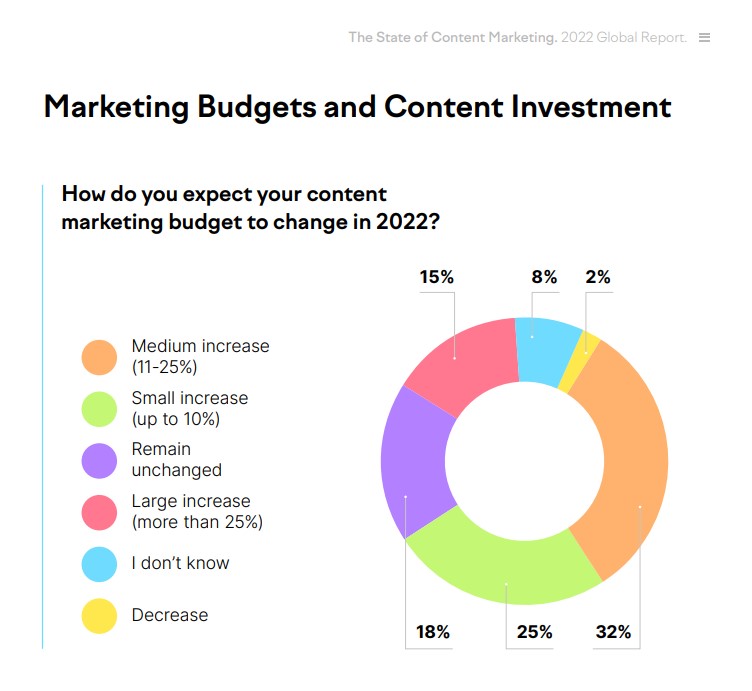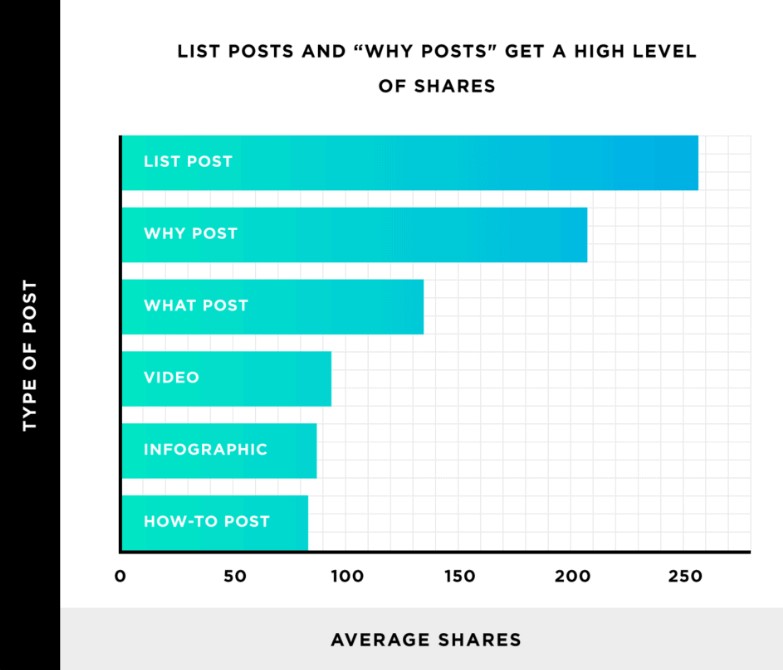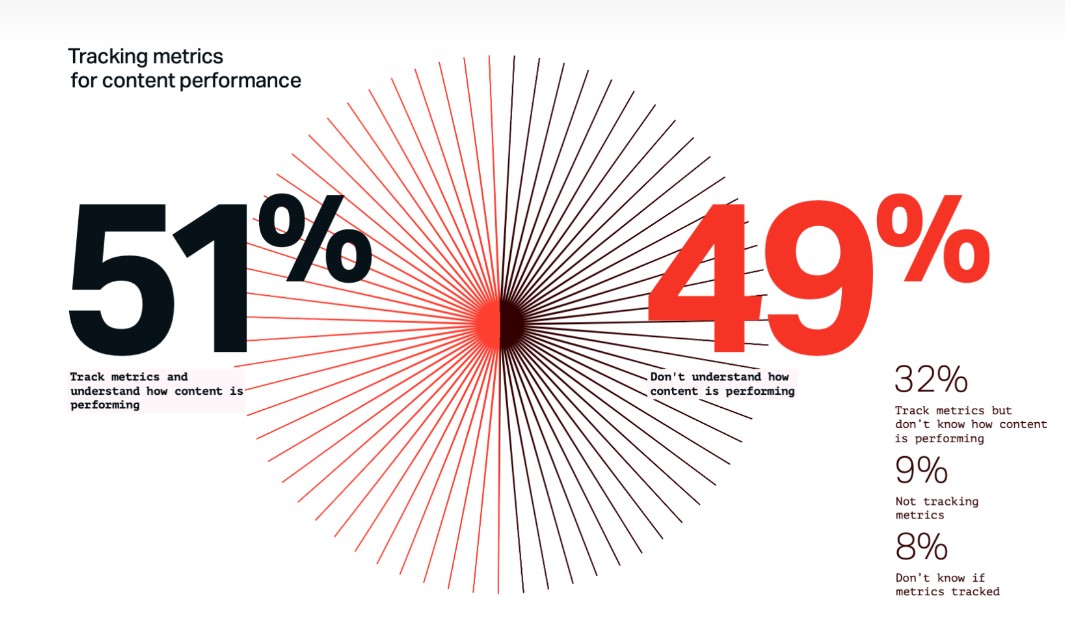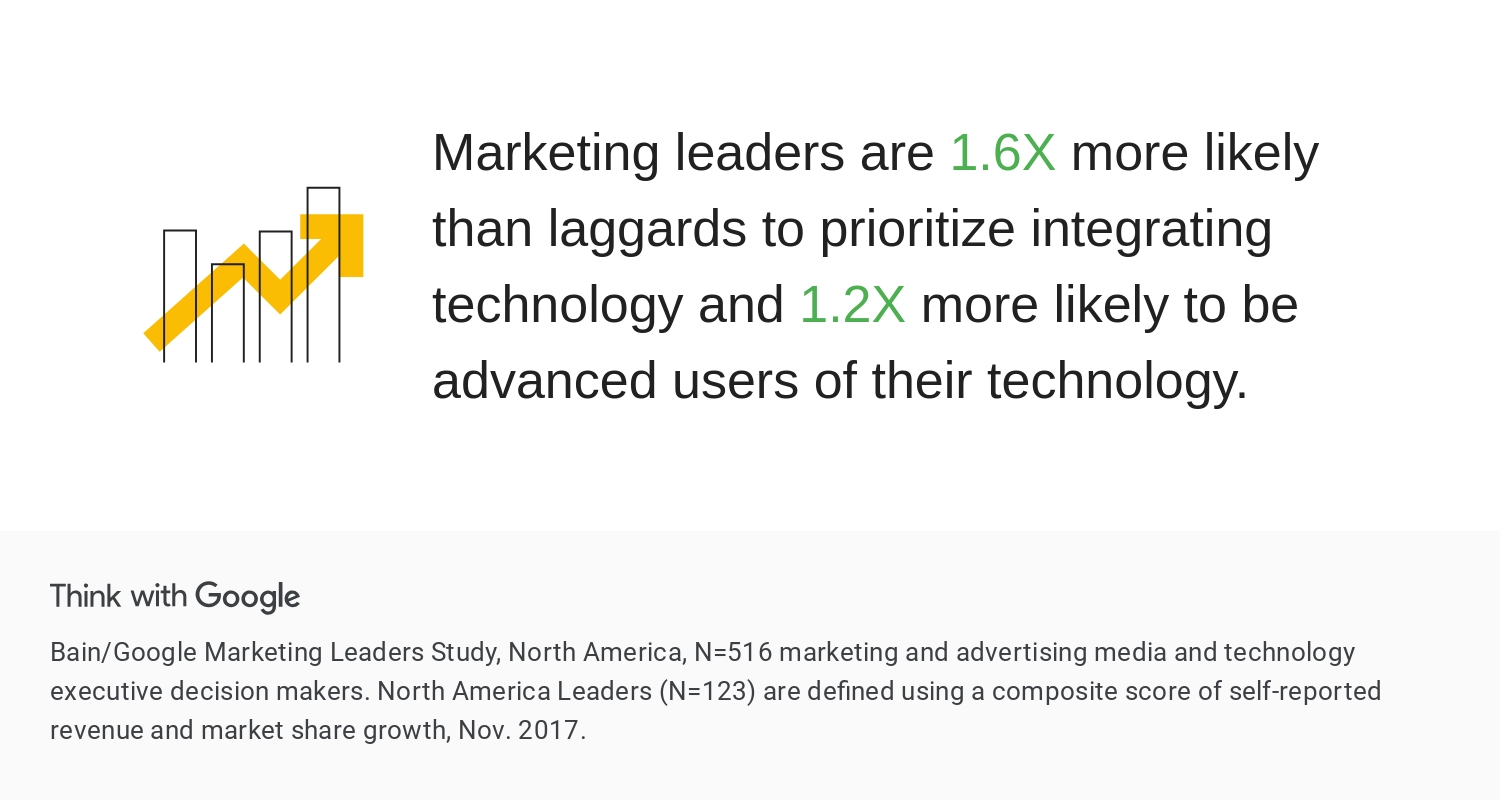The content marketing landscape is so dynamic that what worked for you last month or the month before could drive no results for you today. There are new competitors springing up every day, search engine algorithms keep changing and new trends emerge faster than ever. To navigate your way through this volatile and ever-changing landscape, it is doubly important to stay on top of the latest content marketing statistics and trends.
Content marketing itself is a very wide area of digital marketing. It involves different content formats from written content to visual content to audio content to interactive content and more. So when you’re talking about the latest content statistics, you should also consider video marketing statistics, social media marketing statistics and so much more.
That is why we’ve decided to look at each of these different subsets of content marketing individually here. Without much ado, let’s dive into some of the most important content marketing stats and trends that every content marketer should know.
- Content Marketing Statistics and Trends
- Content Strategy Statistics
- Content SEO Planning Statistics
- Visual Content Marketing Statistics
- Audio Content Marketing Statistics
- Social Media Content Marketing Statistics
- B2B Content Marketing Statistics
- B2C Content Marketing Statistics
- Content Marketing ROI Statistics
- Marketing Technology Statistics
TL;DR – Here’s a quick video highlighting some of the key statistics from this post.
Content Marketing Statistics and Trends
- 80% of content marketers plan on creating more content than the previous year according to the Content Matters 2022 Report by Parse.ly
- 48% of companies with a strong content marketing strategy consider blog content creation as a core content marketing activity, says HubSpot. 56% of marketers find blogging to be very effective and 10% find blogs deliver the biggest ROI among all content types.
- 54% of decision-makers (buyers) say they spend more than an hour every week reading thought-leadership pieces but more than 70% say that nearly half of thought-leadership content delivers no valuable information. This was found in the 2021 LinkedIn-Edelman B2B Thought Leadership Impact Study.
- Spending on content marketing is also likely to increase as a majority of content marketers plan to increase their content marketing budget in 2022, according to State of Content Marketing 2022 Global Report by SEMrush. 47% of marketers plan to increase spending by 11% or more, while another 25% of marketers hope to increase their budget up to 10%.

:Source: SEMrush
- According to the 12th Annual Content Marketing Survey by CMI and MarketingProfs, the 4 major areas of content marketing investment in 2022 are likely to be videos (69%), events (61%), owned media assets (57%), and paid media (55%).
- The SEMrush survey, however, found that the top 3 key areas of investment in content marketing in 2022 will be Social Media and Community Building (41%), Better quality of written content (40%), and Content distribution and promotion(40%) – with Video (35%) at number 4.
- 47% of companies plan to grow their content marketing teams in 2022, according to SEMrush.
- While HubSpot says that the top three roles brands plan to hire for on priority are Content Creators, Content Marketing Managers, and Content Strategists.
Content Strategy Statistics
- HubSpot’s State of Content Marketing Report 2021 said that 82% of marketers actively use content marketing as an integral part of their strategy.
- Nearly 57% of content marketers have a documented content strategy according to SEMrush.
- The same SEMrush report also reveals that only 19% of marketers believe their content marketing strategy is at an advanced stage in terms of maturity. Though 36% do believe that their content marketing strategy is fairly developed.
- A Venngage survey found out that nearly 58.4% of marketers made a reasonable amount of changes to their content marketing strategy after the Covid-19 pandemic, while another 38% of marketers said they made many more changes.

Source: Venngage
- Content ideation is among the top 10 content marketing challenges with 25% of respondents voting for it in the SEMrush survey. The top 3 challenges are, however, quality lead generation with content, generating traffic and promoting content, and creating optimized content that resonates with the audience.
Content SEO Planning Statistics
- HubSpot found in The State of Media & Content Planning in 2022 that organic search and SEO are leveraged by 36% of marketers and media planners. 45% of them also say that these efforts bring the highest ROI.
- HubSpot also found that nearly 64% of marketers today believe mobile optimization to be a necessary and effective area of investment.
- According to the SEMrush State of Content Marketing Report, ‘SEO in content marketing’ is among the top 10 trending topics related to content marketing, second only to ‘Social media content marketing‘.
- Marketers are spending more time auditing and optimizing content, which includes improving UX on their blog/website (36%), identifying top-performing content (34%), finding content gaps (34%), and improving SEO and SERP rankings (33%).
- Searchers use Google autocomplete suggestions in their search 23% of the time, according to Backlinko. This makes it crucial to include relevant keywords/ phrases from these suggestions in your SEO content strategy.
- Content marketers who proactively plan their content marketing campaigns increase their chances of success by 331%, according to CoSchedule.

Source: CoSchedule
** Find more content SEO statistics here.
Visual Content Marketing Statistics
- According to Venngage, 48.2% of marketing content in 2020 included visual content. Also, 63.2% of businesses said they will rely heavily on visual content in 2021 and 2022, so these numbers only seem to be growing.
- 86% of businesses use video content as a core marketing tool, according to Wyzowl.

Source: Wyzowl
- The top 4 reasons for not using video marketing as part of their content strategy by marketers in the Wyzowl report include lack of time (23%), not knowing where to start (16%), lack of interest (13%), and high costs of production (10%).
- As of 2021, YouTube was the most popular platform for consumers when it comes to watching video content, with 35% of respondents voting for it in a HubSpot survey. Facebook and TikTok are the second and third most popular channels.
- The Wyzowl survey shows that 86% of marketers have been able to increase lead generation with videos. This number has consistently been rising since 2019.
- Infographics are very popular among the latest trends in visual content marketing, with nearly 45% of marketers already investing in them according to HubSpot. 38% of those who haven’t experimented with infographics yet, plan to invest in this visual format in 2022.
Audio Content Marketing Statistics
- 53% of marketers find audio content like podcasts to be effective digital marketing tools, according to HubSpot research. Though only 1% of them think it yields any considerable ROI, 80% still plan to invest in audio content in 2022 as they feel it drives engagement and helps build brand awareness.
- Audio chatrooms (like Clubhouse and Twitter Spaces) are trending in 2022 as 68% of marketers who are already using this marketing tool say that it’s extremely effective as a social media marketing strategy, though the ROI is low right now.
- Despite the growing popularity of podcasts and other audio content formats, only 11% of marketers consider audio content as a key area for investment in 2022, according to the SEMrush survey.

Source: SEMrush
- 68% of the U.S. population listened to online audio content in 2020 and 2021, according to The Infinite Dial 2021.
- Spotify is the most popular platform to consume audio content like podcasts, according to Statista.
Social Media Content Marketing Statistics
- The SEMrush State of Content Marketing report lists organic social media (69%) as the number 1 channel used for content distribution, followed closely by email marketing (54%).
- Short form videos are the most popular content type used by marketers on social media with 85% of marketers saying that it is the most effective. Live streaming and videos are a close second with 70% of marketers vouching for their effectiveness.
- List posts are a highly shared content type on social media. List posts are shared 218% more than how-to posts on social media, according to Backlinko’s research.

Source: Backlinko
- 67% of marketers have plans of increasing their investment in TikTok as a social media marketing channel.
- Social media is not just a platform for B2C buyers. More than 84% of B2B decision-makers also use social media to make important purchase decisions.
B2B Content Marketing Statistics
- 46% of B2B marketers plan to increase their content marketing budgets anywhere between 1% to 9% in 2022, according to the CMI/MarketingProfs survey.
- Virtual events as a marketing tool seem to have taken off during and after the Covid-19 pandemic. 58% of B2B marketers said that virtual events produced the best results for them in 2020-21, among all B2B content assets.
- 55% of B2B buyers say that if a piece of though-leadership content does not kindle their curiosity or interest, they are likely to move on to other content within a minute.

Source: Edelman
- LinkedIn continues to be the preferred social media platform for B2B content distribution, after owned channels like websites and blogs.
- More than 67% of B2B content marketers invest most of their time and resources in top-of-the-funnel content creation, according to Databox.
- Email marketing, social media ads and blog posts are among the top performing content for B2B marketers according to CoSchedule. The lowest performing content includes billboards, podcasts, and TV/Radio ads.
B2C Content Marketing Statistics
- 81% of B2C marketers feel that their content marketing efforts were very, or at least moderately, successful over the past 12 months. This is according to the B2C Content Marketing Benchmarks, Insights for 2022 by CMI and MarketingProfs.
- In B2C content marketing, Influencer Marketing continues to provide the biggest ROI, followed by short-form videos and permanent social content, according to HubSpot.
- The same survey by HubSpot also revealed that 51% of B2C marketers are planning to spend more on content marketing in 2022.
- The top content marketing goals of B2C marketers in 2022 are increasing brand awareness (49%), advertising products (44%), and increasing revenue (43%).

Source: HubSpot
- B2C marketers strike a very fine balance between outsourcing content and managing it in-house. 50% of marketers said they outsource at least one content marketing activity while 50% did not.
Content Marketing ROI Statistics
- 51% of content marketers say they understand how their content is performing and track relevant metrics to measure performance, according to the Parse.ly survey. But a huge 49% are still clueless about gauging content performance accurately.

Source: Parse.ly
- Only 35% of marketers believe measuring their content ROI is ‘Very’ or ‘Extremely’ important, according to HubSpot’s State of Marketing report 2021.
- HubSpot reveals that email marketing, social media content (both paid and organic), and organic search have the highest ROI among all content marketing channels.
- 30% of content marketers consider maximizing content ROI as one of their primary goals in marketing, which means seeking tangible and real results from the content they publish.
- Influencer marketing seems to be generating a very high ROI as 57% of marketers find it to be effective and 11% also say it had the highest ROI when they tested different trends.
- Native ads are growing in popularity as 36% of content marketers say it’s effective and almost 5% call it their best ROI-generating strategy.
- ROI in video marketing is measured on the basis of engagement (62%), views (61%), and leads or clicks (60%) that videos get, according to the Wyzowl survey.
Compare these statistics with the content marketing ROI statistics we curated in 2020 to see how the landscape has changed.
Marketing Technology Statistics
- 62% of marketers surveyed by CoSchedule don’t use any kind of project management software to manage their content marketing projects, despite the fact that project management tools evidently contribute to marketing success.
- According to Google, marketing leaders are 1.6 times more likely to adopt marketing technology and 1.2 times more likely to use technology for advanced solutions, as compared to followers.

- The CoSchedule report also shows that only 30% of marketers use project management software, 23% use marketing automation platforms and 34% use SEO planning platforms.
- 51% of marketers surveyed by Parse.ly are investing in the right content management tools, but a greater percentage are investing in hiring content creators. Hiring more people but without empowering them with marketing technology will only slow down the content process.
- When it comes to visual content though, 41% of marketers use an online tool or graphic maker, the Venngage survey revealed.
Conclusion
From all of the content marketing statistics and trends that we’ve seen above, it is evident that businesses are taking content a lot more seriously in their digital marketing campaigns today. From increasing investments in content marketing to getting a better understanding of content marketing ROI, the industry is gradually maturing one step at a time. But there is still a long way to go. In terms of marketing technology adoption, for instance, many content marketers are still lagging behind. For some, it is due to a lack of funds while for others it is just a lack of awareness. It is important to remember, however, that the early adopters are usually the ones that lead till the end. With this note, hope these insights help you build a stronger content marketing strategy for the days ahead. And if you found these statistics useful, do check out our compilation of 30+ content creation statistics for 2022 as well.





